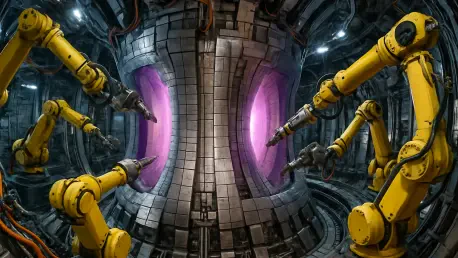What happens when the quest for limitless clean energy collides with environments so hostile that no human can set foot inside? Fusion reactors, the pinnacle of sustainable power aspirations, operate under conditions of intense radiation and extreme heat, mimicking the sun’s core. This reality poses a monumental challenge: maintaining these reactors without risking human lives. Enter the world of advanced robotics—machines designed to brave the uncharted dangers of fusion energy systems, offering a glimpse into a future where technology safeguards both humanity and innovation.
Why Robots Are Essential for Fusion Energy Safety
The promise of fusion energy as a boundless, clean power source comes with a steep price—environments lethal to human workers. Inside a fusion reactor, radiation levels and temperatures can be catastrophic, rendering traditional maintenance methods obsolete. Robotics emerges as the only viable solution, capable of withstanding these perils while performing critical tasks. This shift isn’t merely about convenience; it’s about survival and the ethical imperative to protect lives.
By deploying robots, the energy sector can push boundaries without endangering personnel. These machines are engineered to navigate treacherous conditions, ensuring that the dream of fusion power doesn’t falter due to operational hazards. The focus on robotic intervention signals a transformative approach, prioritizing safety while enabling continuous progress in energy research.
The High Stakes of Maintaining Fusion Reactors
Maintaining a fusion reactor is akin to servicing a star on Earth. The colossal components, often weighing several tons, must be assembled and repaired with precision in zones where radiation exposure would be fatal within minutes. Human involvement in such settings isn’t just impractical—it’s impossible. This underscores the urgent need for automated systems that can handle the scale and danger of these tasks.
Beyond individual safety, the implications ripple out to global energy sustainability. Fusion power holds the potential to revolutionize how the world meets its energy demands, slashing carbon emissions and reducing reliance on finite resources. However, without reliable maintenance solutions, this vision remains out of reach, highlighting why robotic advancements are critical to bridging the gap between theory and reality.
Innovations Driving Heavy-Duty Robotics Forward
At the forefront of this technological revolution are groundbreaking developments in robotic design, particularly from research hubs focused on fusion challenges. A standout innovation is a redesigned robotic joint boasting a reduction ratio of 13,806:1 and a torque capacity of 139 kNm. With minimal backlash of just 4.86 arcmin, this joint can manipulate massive reactor components with extraordinary accuracy, addressing the physical demands of fusion environments.
Equally impressive is an AI-driven peg-in-hole assembly method, inspired by human hand-eye coordination. By integrating data from a 2D camera and force/torque sensors, this technique achieves sub-0.1 mm precision in radiation-heavy settings, eliminating the need for complex 3D vision systems. Such precision ensures that even the most intricate tasks can be executed flawlessly under hostile conditions.
Lastly, environmental perception takes a leap forward with TCIPS, a Transformer-based model that segments 3D point cloud data into geometric shapes for enhanced navigation. This system excels at capturing long-range spatial relationships and refining boundary detection, enabling robots to maneuver through cluttered reactor layouts safely. Together, these advancements form a robust toolkit for tackling the unique obstacles of fusion maintenance.
Insights from Pioneers in Robotic Research
Experts at the forefront of this field emphasize the synergy between mechanical prowess and intelligent systems as the cornerstone of future reactor maintenance. Published findings in renowned journals reveal a consensus: integrating high-torque designs with AI is not a distant goal but a present necessity. One researcher noted that “combining raw strength with adaptive intelligence mirrors the only path to autonomy in such extreme conditions,” reflecting the urgency of these solutions.
The broader scientific community echoes this enthusiasm, recognizing the global impact of such innovations. Reports suggest that these developments could reduce maintenance downtime by up to 40%, a statistic that underscores their potential to accelerate fusion energy timelines. This collective confidence lends credibility to the idea that robotics will redefine how hazardous energy systems are managed.
A Roadmap for Autonomous Reactor Upkeep
Turning these cutting-edge technologies into practical applications requires a clear strategy for integration. High-torque robotic joints can be deployed for the heavy lifting of in-vessel components, ensuring structural integrity during replacements or repairs. This step addresses the sheer physicality of fusion maintenance, minimizing risks associated with manual intervention.
For precision tasks in irradiated zones, AI-based assembly methods offer a reliable approach, executing complex alignments with unparalleled accuracy. Meanwhile, TCIPS enhances navigational safety, allowing robots to interact seamlessly with intricate reactor environments. This framework not only reduces human exposure to danger but also boosts operational efficiency, providing a blueprint for stakeholders to implement automated solutions in active fusion plants starting from 2025 onward.
Looking ahead, collaboration between engineers and energy policymakers will be essential to scale these systems. Pilot programs could test robotic protocols in simulated reactor settings, refining their capabilities before full deployment. This structured adoption ensures that the transition to autonomous maintenance aligns with both technical feasibility and safety standards, paving the way for a new era in energy infrastructure.
Reflecting on a Robotic Revolution
Looking back, the strides made in robotics for fusion reactor maintenance marked a turning point in the pursuit of clean energy. The fusion of mechanical innovation with artificial intelligence had tackled challenges once deemed insurmountable, from handling massive components to navigating deadly environments. Each breakthrough had brought the vision of sustainable power closer to reality, proving that technology could shoulder burdens too heavy for human hands.
The path forward demanded sustained investment in research and real-world testing to refine these systems further. Partnerships across industries had to prioritize scaling robotic solutions, ensuring they met the rigorous demands of operational reactors. As these efforts unfolded, the legacy of this work stood as a reminder that innovation, when guided by necessity, could transform even the most daunting obstacles into opportunities for progress.









